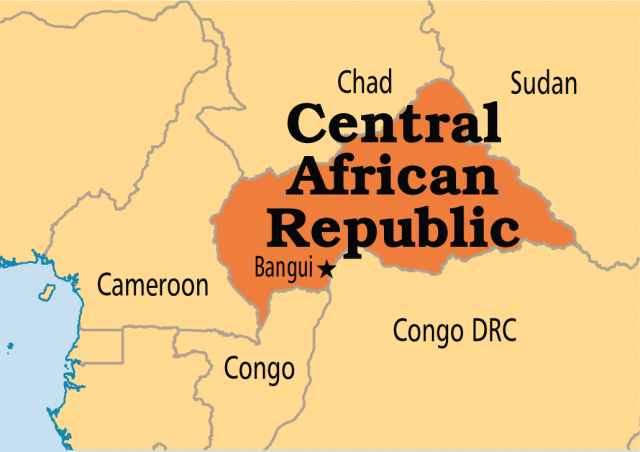Central African Republic
Area 240,535 square mi (622,984 square km)
Population 4.709 million (2014)
Capital Banqui
Highest Point 4,658 ft (1,420 m)
Lowest Point 1,099 ft (335 m)
GDP $1.783 billion (2014)
Primary Natural Resources diamonds, uranium, gold.
DEEP IN THE HEART of the African continent, the LANDLOCKED Central African Republic is on a heavily forested plateau about the size of TEXAS between the Chad and CONGO RIVER basins. It is bounded on the north by CHAD, SUDAN to the northeast, the Democratic Republic of the CONGO (formerly Zaire), CONGO to the south, and CAMEROON to the west. The area has a tropical climate with two annual wet seasons, May-June and October-November. However, in the very dry summer, the Harmattan, a hot, dust-laden wind blows in from the SAHARA DESERT with a saunalike effect in the cities.
From the 1500s until the 1800s, the area was ravaged by the slave trade. In 1894, the French occupied the region, then called Oubangui-Chari, and combined it administratively with Chad, GABON, and the Middle Congo to become French Equatorial Africa. In 1946, the French granted internal self-government. On August 13, 1960, President David Dacko proclaimed complete independence but alarmed the Western powers when he aligned with communist CHINA. He was overthrown in a coup on December 31, 1965, by Jean-Bedel Bokassa, his cousin and army chief of staff, who then declared himself Emperor Bokassa I.

Allegations of brutality and excess characterized his regime, with Amnesty International charging he participated in the massacre of 80 schoolchildren. In 1979, he was ousted by a coup supported by French paratroopers. Dacko returned to power, but an army coup deposed him again. From 1996 to 1998, violence between the government and rebel groups prompted the United Nations to send in an all-African peacekeeping force. Although elections were held in September 1999, repeated coups have followed.
Although the nation is rich in natural resources, including diamonds, gold, and oil, more than 70 percent of its citizens are subsistence farmers working only 3 percent of the land. Large stands of timber cover 75 percent of the country and surveys suggest extensive additional mineral wealth. Poaching has diminished the republic's reputation as one of the last great wildlife refuges and the populace suffers from a high mortality from AIDS, with 13 percent of the population HIV positive. Life expectancy is 41.71 years.
The official language is French, but Sangho is used for commerce and intertribal communication between 80 ethnic groups, of which the largest are Baya (34 percent), Banda (25 percent), Nabandi (11 percent), Azande (10 percent), and Mbaka (5 percent). In July 1990, a decree gave the nation's 10,000 pygmies full citizenship. A small European community remains, the majority of which are French or Portuguese descendants. Christians account for 83 percent of the population, of which 33 percent are Roman Catholic and 50 percent are Protestant. An estimated 12 percent of the population follows animist traditions and 3 percent are Islamic.